Go googling and you will come across many tips and opinions about the mast rake for the windfoil or wingfoil. In this article we explain the basic idea of changing the angle of the fuselage relative to the bottom of the board and tilting the mast forward or backward.
Adjusting mast rake, what do we actually mean?
There is often talk of ‘ adjusting the mast rake’. In most cases, most foilers mean ‘ adjusting the angle of the fuselage/front wing relative to the bottom of the board’. Of course you change the angle of the fuselage/front wing by tilting the mast forward or backward. But it is mainly the change in the angle of the fuselages/front wing compared to the bottom of the board that makes the biggest impact. And because 2 aspects change when moving the mast forwards or backwards, we like to use 2 different terms for the explanation:
- 1) Adjust angle of the fuselage/front wing relative to the bottom of the board
- 2) Mast rake adjust
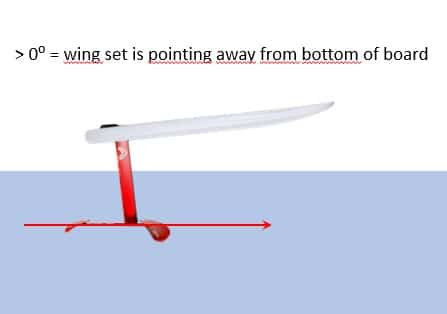
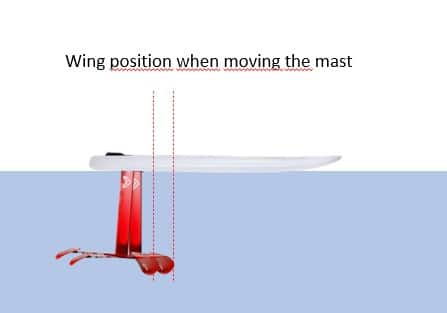
1. Adjusting the angle of the fuselage/front wing
Adjusting the angle of the fuselage/front wing relative to the bottom of your board has a big impact during foiling at 3 moments;
- 1. The moment your board is still floating on the water, so the phases from bobbing to planing and getting on the foil
- 2. While wingfoiling or wind foiling
- 3. Moments of a nose drop ;(
1.1 Phase in which board floats on the water
In this phase of low speed, the board is leading and goes horizontally through the water. At a positive* angle, the foil is pulled down (figure 1). Only from a certain speed (when the foils start to generate enough lift) the tip of the board is pushed upwards and the wingset goes horizontally through the water. In many cases, this is the moment that you actually get off the water. Until then, the board sticks to the water longer because the foil wants to go down and the board presses more firmly on the water. As a result, you are less likely to get on the foil. So you need more wind to get on the foil. With a negative/more negative angle (figure 2) you can get to the foil more easily, because the foil tends to go up and pushes the board up, as it were.
* The angle is always measured at the front of the mast and compared to the fuselage (often) directly behind the front wing.
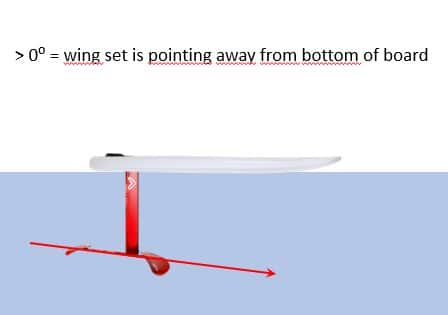
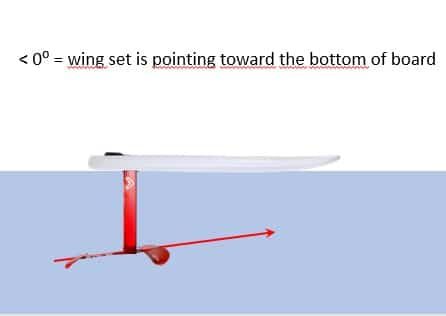
1.2 Phase in which you are foiling
When you are foiling, the foil is leading and goes horizontally through the water. With a positive rake (figure 1.1.), the tip of your board points slightly upwards. Most foilers experience this as a ‘nice’ feeling (in contrast to the situation where the nose of the board continuously points towards the water). Because the tip points slightly upwards, more wind passes under the board than it does. This gives you more lift. This also gives more power. Even though the angle is very small, you are still a little more comfortable if your back foot is slightly lower than your front foot. Especially with half wind foiling you notice that.
At an angle of 0 degrees or lower, the nose of the board tends to go down during foiling (figure 2.1), because more wind comes over the top of the board. This often feels under powered. You are also less ‘in control’ emotionally. In wind foiling, many foilers try to compensate for this by tilting the sail far back. A wingfoiler will tend to stand more backwards or hang back slightly.
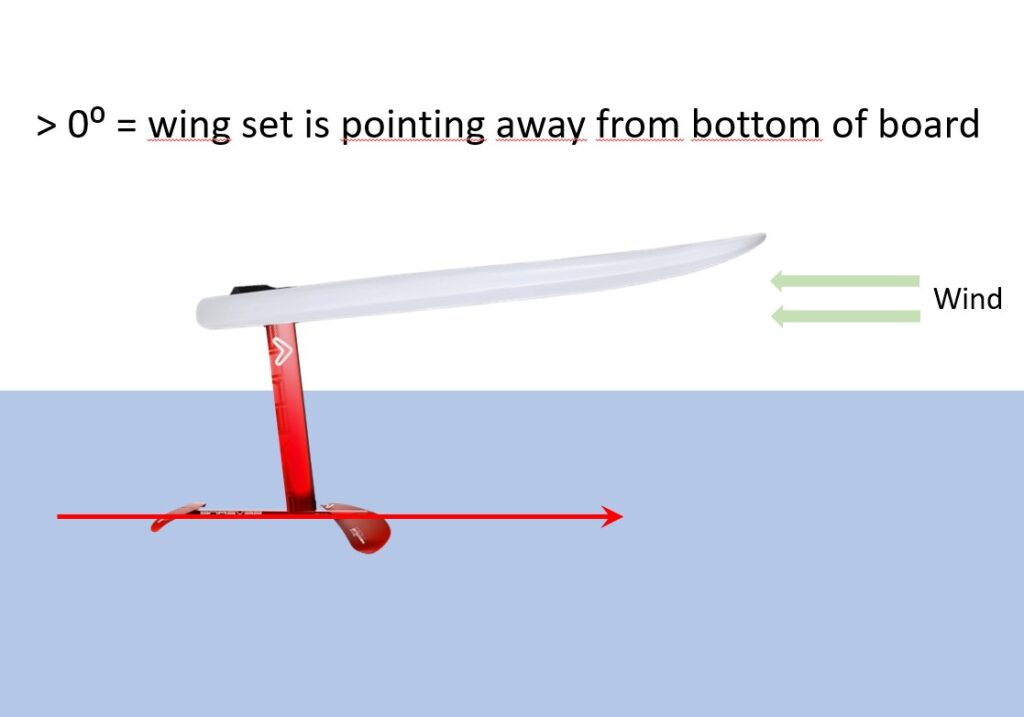
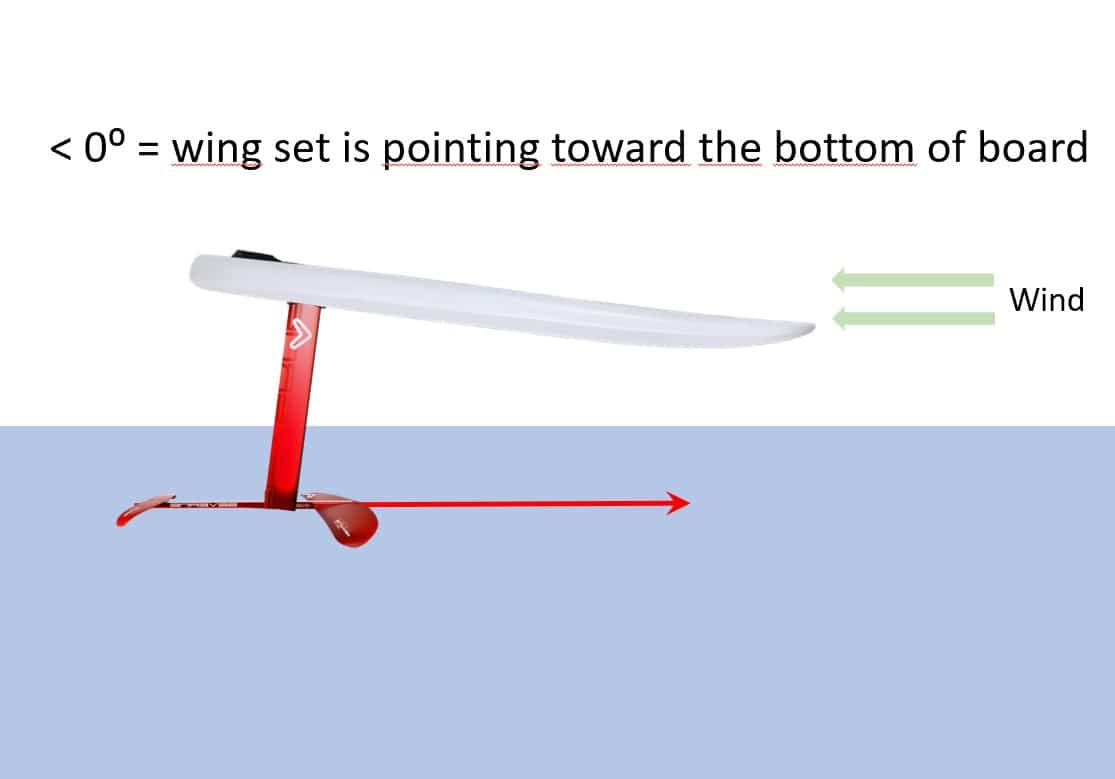
1.3. Moment of a nose drop
We all know it, the well-known nose drop. In many cases you still have enough speed to keep foiling, but for various reasons the foil loses the lift to keep the board in the air. However, as soon as the board hits the water (and there is often still sufficient speed), the foil will again tend to go horizontally through the water. If the angle of the wingset to the board is large enough, the board is easily pushed back up (figure 1.1.). If the angle is 0 degrees or lower, the board brakes very badly and sticks to the water (figure 2.1.). Again because the foil likes to go horizontally through the water. As a foiler, you often end up in the water a few meters in front of your board.
You can feel it coming: with waves and strong winds you want to have enough power, stand comfortably and that the board bounces off the water when the nose hits a wave or makes a nose drop. And this is exactly why many PWA foilers and also IQfoil foilers with more wind want to foil with a larger angle.
2. Adjust mast rake
As indicated above, the angle of fuselage/front wing is adjusted by tilting the mast forward or backward. However, by moving the mast forwards or backwards, the position of the wings in relation to the board is also changed (figure 3). This also has an effect on where the lift point is located.
Example: Suppose you have a mast of 95 cm and you change the angle of the mast by 1.5 degrees, then the wingset slides forward or backward by about 1.5 to 2 centimeters. You notice this very well during foiling.

2.1. With little wind more lift
With little wind you want to have more lift to get on the foil quickly and have good power to go as fast as possible in low wind conditions. By tilting the mast slightly forward, the wingset is also more forward, so you experience more lift and power in the foil. Windfoilers often also experience more power in the sail. A wingfoiler will tend to stand a little further forward. If there are foot straps on the board, it is best to place the complete foil slightly backwards. The risks of nose drops are also less with little wind, so from that perspective you also need a smaller angle of the fuselage/front wing.
2.2. With a lot of wind, more control and less lift
By tilting the mast backwards with more wind, the wingset also comes further back. As a result, the lift point also goes backwards, you have more control and you can hang back a little more relaxed. In these conditions it is often no problem to get on the foil easily, so with more wind, a larger angle is also no problem. A wingfoiler will tend to stand a little further back. If there are foot straps on the board, it is best to place the complete foil slightly forward. With more wind/waves, the risk of nose drops is also greater, so a larger angle of the fuselages/front wing is also nice.
Doesn’t trimming the back wing do the same?
Yes and no. Yes, because by increasing the angle of the back wing you get more lift during foiling and the nose will also tend to rise slightly. Only the faster you go, the more lift you get. You hardly have that effect with adjusting the rake of the mast.
On the other hand, at a low speed (often if you are not yet on the foil) the impact of an adjusted angle of the back wing is not yet so great, while a smaller rake of the mast does.
In addition, we have sailed with a number of wind foils with a standard rake of 0 degrees, where trimming the back wing does not have the necessary effect, but adjusting the rake of the fuselage / wings does. Only then did we feel a balance in the set and we stood comfortably. In this case, tuning the back wing did support the intended effect.
What is the right angle?
There is no ‘right’ angle. The most optimal angle depends on:
- The bottom shape and length of the board
- The conditions in which you sail
- How important it is to get on the foil quickly/easily
- Own weight and ‘foil style’
Can you give something of a rule of thumb?
In the IQfoil class there is more variation with the rake than with the PWA, simply because in the IQ class they foil in many more different conditions. From flat water with 6 to 8 knots to 3 meter high waves with 24 knots or more. Many IQfoilers foil with a rake that varies between 1.5 and 3.0 degrees. In the PWA they sail more often with more wind and with more waves. Most riders foil with a rake of between 3 and 3.5 degrees.
The above is a nice starting point, but keep in mind that for both the IQfoilers and the PWA riders, getting on the foil quickly is generally not an issue! This has everything to do with the fact that in races the riders are already on the foil long before the start and they also assume that they stay on the foil during the races or come back on the foil with 1 or 2 pump strokes after tacking.
With wind foiling we like to foil with little wind with coarse racing (up to about 12 knots) half wind and down wind with a rake of around 2 degrees or more. While upwind with the same wind we prefer a little less than 2 degrees. This gives us more pressure on the back foot and we can push upwind better. With slalom foils we prefer to use a rake between 3.0 and 3.5. This gives more control and we are more relaxed.
With wingfoiling we foil on short boards (5 feet) with an angle of 1.5 degrees and with somewhat longer boards (< often with less wind), we do not use a rake spacer. With some wingfoil masts, the rake is then between 0 and 1 degree. With little wind, getting on the foil easily and quickly is very important. Nose drops with a longer board are often easy to catch, so a large rake is not necessary.
Below is a table with a general guideline as a starting point. Again, there is no “best” or right or wrong. Get started with this yourself and find out what feels best for you.
| Little wind / flat water | Little wind with waves | Lots of wind with waves | |
| Windfoiler | Rake 1.5 – 2 degrees | Rake from 2 to 2.5 degrees | Rake from 3 to 3.5 degrees |
| Wingfoiler short board (< 5’6″) | Rake 0 degrees | Rake from 0.5 to 1 degree | Rake from 1.5 to 3 degrees |
| Wingfoiler longer board (> 5’6″) | Rake 0 degrees | Rake of 0.5 degree | Rake from 1 to 2 degrees |
How to measure the rake?
To measure the rake of the fuselages / wings you can use an app such as Bubble or purchase a handy device. Step 1 is to set the angle to zero immediately BEFORE the mast (reset app or device) and then place the phone or device on a flat section directly behind the front wing. The number you sit is the angle of the fuselages/front wing relative to the bottom of your board.
Tools to adjust rake
For the various types of foils there are various sets available with which you can change and fix the angle of the mast.
-
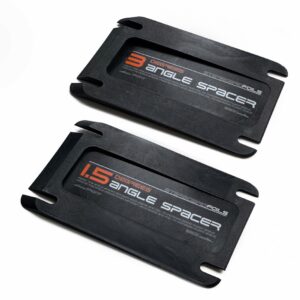
Starboard rake spacers top plate
€17,95 incl. VAT Select options This product has multiple variants. The options may be chosen on the product page -
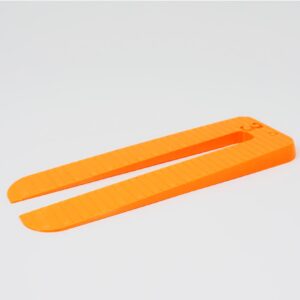
Mast rake shim
€17,95 incl. VAT Select options This product has multiple variants. The options may be chosen on the product page -
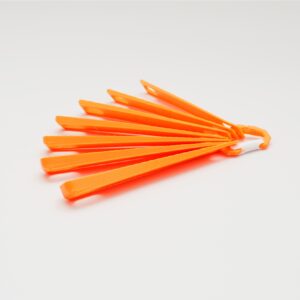
Mast rake shim set
€32,95 incl. VAT Add to cart


